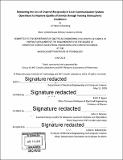Simulating the use of channel reciprocity in laser communication system operations to improve quality of service through varying atmospheric conditions
Author(s)
Eichenberg, Neal (Neal Thomas)
DownloadFull printable version (7.742Mb)
Other Contributors
Massachusetts Institute of Technology. Department of Electrical Engineering and Computer Science.
Advisor
Erich P. Ippen and John D. Moores.
Terms of use
Metadata
Show full item recordAbstract
This project's goal was to develop a simulation model to conduct design analysis and to illustrate the positive and negative aspects of utilizing channel reciprocity versus interleaving. There were three project objectives. The first was to create a numerical model of a laser communications system that included either channel reciprocity or interleaving to mitigate the effects of atmospheric turbulence. This model was implemented in MATLAB* and Simulink*. The second task integrated the model with a graphical user interface (GUI), which provides the user a choice of different configurations and solutions based on the user's design specifications. For example, the user may elect to sweep the scintillation index to see the impact that a variety of turbulence levels have on the bit error rate (BER). The user has the ability to sweep each variable and observe the performance. With this model, the user objectively compares optical communication systems with and without the utilization of channel reciprocity. Scenarios may be run to determine which settings provide the most optimized quality of service (QoS) metrics. The third goal was to test the QoS of both cases against theoretical values in order to check the validity of the MATLAB and Simulink models. These three objectives were met, and channel reciprocity techniques were determined to be an excellent choice for specific conditions. Given the same transmit power, channel reciprocity with and without forward error correction (FEC) achieves a far lower BER than a system that utilizes interleaving and FEC. This low BER is achieved by setting the gating threshold for the transmission of information well above the signal to noise (SNR) requirement. Latency issues could arise, but they are managed in this model by setting the buffer input to output ratio such that the output is always at least twice the input. Although reciprocity without FEC is not a viable solution for all scenarios, it was found that it makes sense to utilize reciprocity without FEC for some cases. However, reciprocity with FEC is recommended for all cases that have round trip durations that are less than the coherence time.
Description
Thesis: S.M., Massachusetts Institute of Technology, Department of Electrical Engineering and Computer Science, 2018. Cataloged from PDF version of thesis. Includes bibliographical references (pages 68-73).
Date issued
2018Department
Massachusetts Institute of Technology. Department of Electrical Engineering and Computer SciencePublisher
Massachusetts Institute of Technology
Keywords
Electrical Engineering and Computer Science.